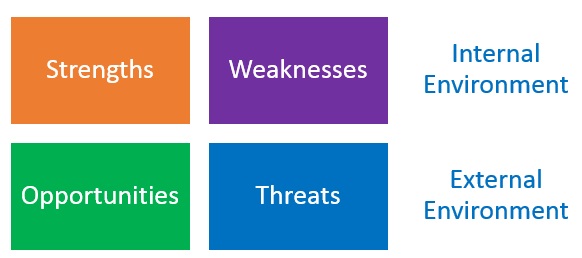SWOT Analysis
S.W.O.T. is an acronym that stands for Strengths, Weaknesses, Opportunities, and Threats.
A SWOT analysis is an organized list of a company’s strengths, weaknesses, opportunities, and threats. The analysis is designed as a structured planning method to identify, separate, and evaluate internal and external factors of a business. Strengths and weaknesses are internal aspects to the company such as reputation, services, products, patents, equipment, and location. These are factors that can be directly managed by the company. Opportunities and threats are external influences such as competitors, suppliers, social trends, regulations, and economy. These are factors a company cannot change, however, they can anticipate and react to them.
S.W.O.T.
Strengths: Factors or characteristics of the business that give it an advantage over its competitors
Weaknesses: Factors or characteristics that place the company at a disadvantage relative to its competitors
Opportunities: Favorable elements or situations in the market environment that can become a competitive advantage
Threats: Unfavorable elements or situations in the market environment that can negatively affect the business
The Goal of a SWOT analysis
The goal of a SWOT analysis is to help companies recognize growth opportunities, leverage resources, optimize performance, and minimize risk. The analysis can help a company develop a solid business strategy by matching its resources and capabilities to the competitive environment in which it does business.
Advantages and disadvantages of SWOT Analysis
Advantages
- Simple and easy to complete
- Very little cost to complete
- Easy to understand
- Visual guide
- Focuses on the key internal and external factors affecting a company
- Assists in the strategic planning process
- Helps to identify future goals and objectives
- Helps in decision making process for future endeavors
- Helps recognize company’s core strengths and position in the market
Disadvantages
- No prioritization of factors
- No mechanism to rank the significance of one factor versus another
- Factors can be very subjective
- Factors are often opinions not facts
- Only single simple level analysis
- Often vague description of factors
- No suggestions for solving issues
Completing a SWOT Analysis
Completing a SWOT analysis is very simple. It can be done by an individual or a group of people. However, it is best be completed as a brainstorming session.
The SWOT analysis is typically presented as a grid or matrix. It is comprised of four quadrants, one for each of the SWOT headings: Strengths, Weaknesses, Opportunities, and Threats.
A basic SWOT analysis is completed in few steps:
Step 1. Create a grid with the four quadrants
Step 2. Label each quadrant (i.e. Strengths, Weaknesses, etc…)
Step 3. Identify and list the company’s key strengths
Step 4. Identify and list the company’s weaknesses
Step 5. Identify and list opportunities in the market environment
Step 6. Identify and list threats in the market environment
Analyzing Each Quadrant
Strengths
Strengths are the company’s positive internal attributes. These are things completely under the company’s control. The company decides how to utilize them and how to benefit from them.
Examples of strength may include;
- products or services
- patents
- strong brand names
- equipment
- intellectual property
- good reputation
- favorable access to distribution networks
- knowledge and expertise
- efficiencies in processing tasks
Weaknesses
Weaknesses are a company’s negative internal attributes. They are factors that are within the company’s control. However, even though they are within the company’s control, they adversely affect the performance of the company. These factors need to be improved upon so they no longer a disadvantage.
Examples may include;
- lack of technologies
- lack of capital
- lack of resources
- lack of patent protection
- weak brand name
- poor reputation
- high cost structure
- lack of access to key distribution channels
- unskilled labors
Opportunities
Opportunities are the positive external factors that may affect a company. These external forces are beyond a company’s control. Opportunities reflect the potential positive direction for a business to grow. They represent possibilities that if taken advantage of can significantly enhance its performance.
Examples include;
- trends in the economic market
- social trends
- weather conditions
- new technologies
- loosening of governmental regulations
- removal of trade barriers
Threats
Threats are the negative external factors that may affect the company. Since they are external factors, the company has no control over them. These can be very detrimental to the company’s growth and stability. However, the company can develop plans to minimize risks.
Examples include;
- trends in the economic market
- poor weather conditions
- increased competition
- social changes
- emergence of substitute products
- new governmental regulation
- increased trade barriers
Additional Links
Seven Management Planning Tools
Process Decision Program Chart



